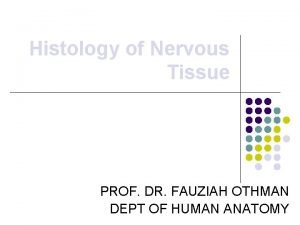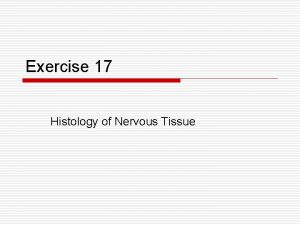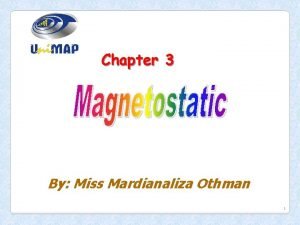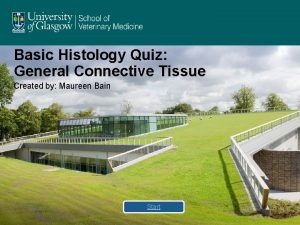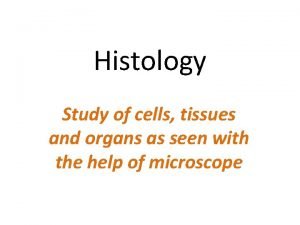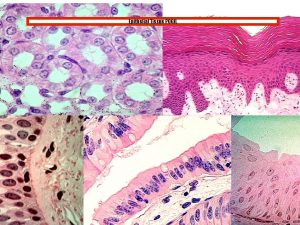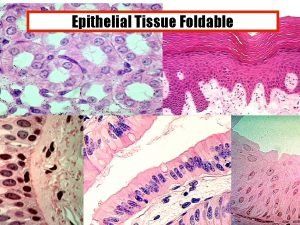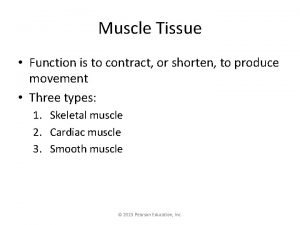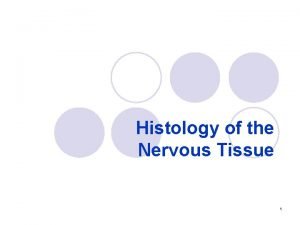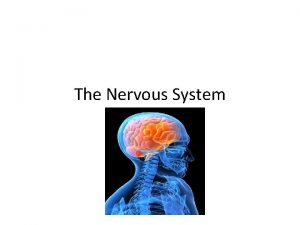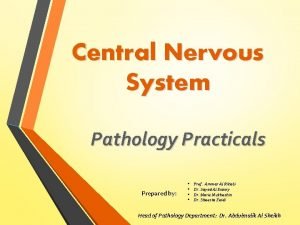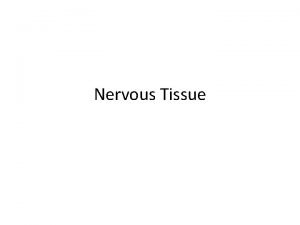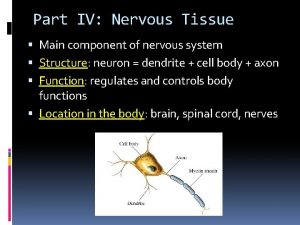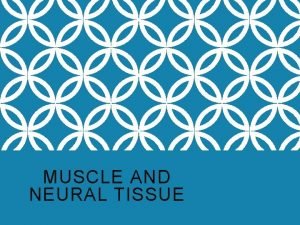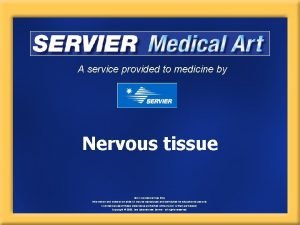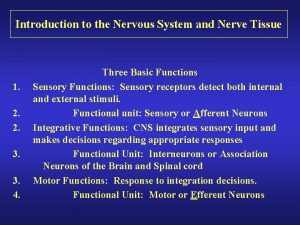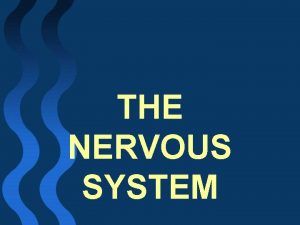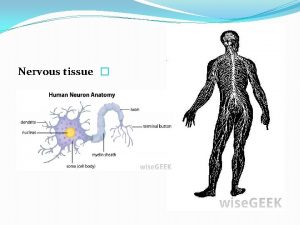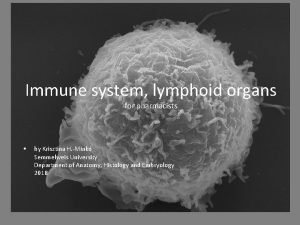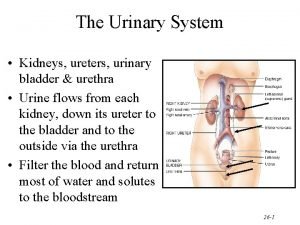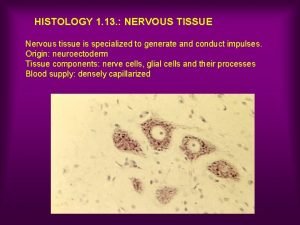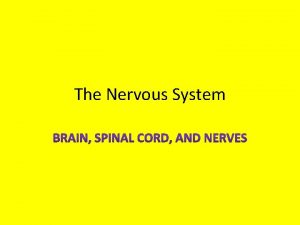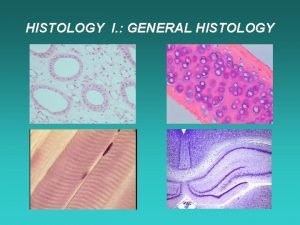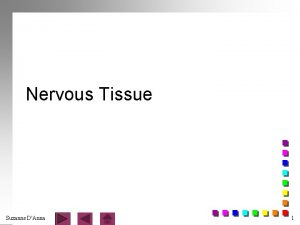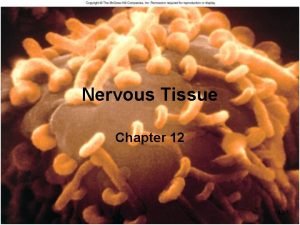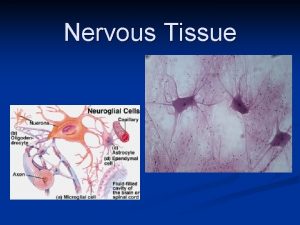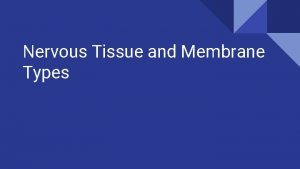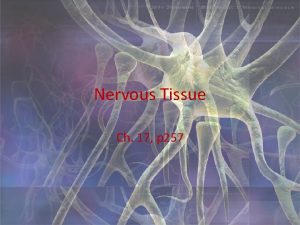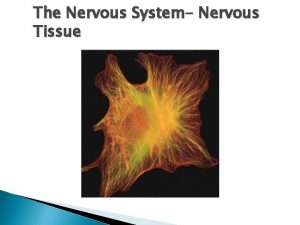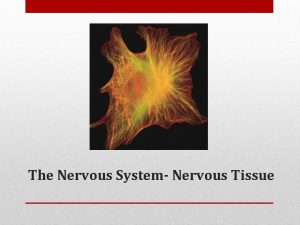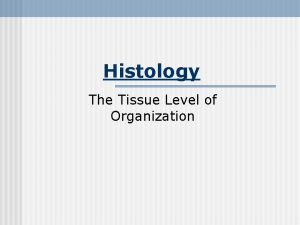Histology of Nervous Tissue PROF DR FAUZIAH OTHMAN







































- Slides: 39

Histology of Nervous Tissue PROF. DR. FAUZIAH OTHMAN DEPT OF HUMAN ANATOMY

l l l l l Feature of nerves tissue Type of cell: neuron & neuroglia General feature of neuron Type of neuroglia: astrocyte, oligodendrocyte, ependymal cell, microglia Synapses Myelin – formation & function General structure of peripheral nerves Ganglia – dorsal root ganglia & autonomic ganglia

l Nervous system divided into: l Central nervous system (CNS) Brain and spinal cord l Peripheral nervous system (PNS) § Cranial and spinal nerves – locate outside the CNS.

Morphology of typical neuron l Neuron functional cell of the nervous tissue. l Cell body or perikaryon - contains the nucleus – regulates the functioning of the neuron. § § § Numerous dendrites and a single axon. Contains Nissl bodies in the cytoplasm Axon hillock- no Nissl bodies l Axon – cellular process (extension) – carries impulses away from the cell body. l Dendrites – cellular process (extension) – carries impulses toward the cell body


2 types of cell i) ii) Neurons (nerve cells) Supporting cells Functions of neurons 1) 2) specialized to receive stimuli and to conduct electrical impulses to other parts of the system. Arranged as an integrated communications network, with several neurons in a chain-like fashion involved in sending impulses from one part of the system to another.

Neuron Classification l Structural: l Multipolar – most common type in CNS. § l Bipolar- not as common purely sensory. § l Include all motor neurons and interneurons of brain and spinal cord. Retina of eye, inner ear, olfactory epithelium in the upper region of nose. Unipolar (formerly known as pseudounipolar) § Sensory neurons found in numerous craniosacral ganglia of the spinal cord.

Comparison of Structural Classes of Neurons

Comparison of Structural Classes of Neurons

Comparison of Structural Classes of Neurons







Unipolar neuron Nucleus & nucleolus Cytoplasm fibrocytes Satellite cells Cytoplasm of neuron Myelinated axons



The supporting cells (neuroglia or glia): l l l Astrocytes Oligodendrocytes Microglial cells Ependymal cells Schwann cells Satellite cells CNS PNS

Astrocytes l l l Largest, most numerous, versatile, and highly branched glial cells They cling to neurons and cover capillaries Functionally, they: l l Support and brace neurons Anchor neurons to their nutrient supplies Guide migration of young neurons Control the chemical environment

Astrocytes

Microglia l Microglia – smallest, ovoid cells with spiny processes - phagocytic cells that migrate through the CNS remove foreign and degenerated material and

Ependymal Cells l Ependymal cells – squamous- to columnarshaped cells l They line the central cavities of the brain and spinal column

Oligodendrocytes l Oligodendrocytes – branched cells that wrap CNS nerve fibers - Produce myelin in CNS

Schwann Cells and Satellite Cells l Schwann cells (neurolemmocytes) – form myelin sheaths around peripheral axons l Satellite cells surround neuron cell bodies with ganglia


Synapse l l A junction that mediates information transfer from one neuron: l To another neuron To an effector cell Presynaptic neuron – conducts impulses toward the synapse Postsynaptic neuron – transmits impulses away from the synapse l l l The region where the terminals come close to another cell and transmit the impulse




Myelin – formation & function l l 1. 2. 3. Whitish, fatty (protein-lipid), segmented sheath around most long axons Its function: Protection of the axon Electrically insulating fibers from one another Increasing the speed of nerve impulse transmission

2 types of neuroglia produce myelin l l CNS= Oligodendrocyte PNS= Schwann cells






 Neuron histology
Neuron histology Exercise 15 histology of nervous tissue
Exercise 15 histology of nervous tissue Cns histology ppt
Cns histology ppt Neuronal pools are collections of
Neuronal pools are collections of Neuronal pools
Neuronal pools Nervous
Nervous Fauziah zen
Fauziah zen Puji yanti fauziah
Puji yanti fauziah Othman line 2
Othman line 2 Othman line 2
Othman line 2 Othman episode 1
Othman episode 1 Othman najmi
Othman najmi Connective tissue histology quiz
Connective tissue histology quiz Thyroid and parathyroid glands
Thyroid and parathyroid glands Characteristics of stratified columnar epithelium
Characteristics of stratified columnar epithelium Lingual tonsil
Lingual tonsil Simple squamous tissue
Simple squamous tissue Pogil epithelial tissue histology
Pogil epithelial tissue histology Tissue fixation
Tissue fixation Type of muscle
Type of muscle Nervous tissue definition
Nervous tissue definition Nervous tissue
Nervous tissue Nervous tissue in the lungs
Nervous tissue in the lungs Nervous tissue in brain
Nervous tissue in brain Nervous system vocabulary
Nervous system vocabulary Nervous tissue
Nervous tissue Nervous tissue in brain
Nervous tissue in brain Nervous tissue
Nervous tissue Muscle and nervous tissue
Muscle and nervous tissue Nervous tissue
Nervous tissue Nervous tissue description
Nervous tissue description Nerve organization
Nerve organization Nervous tissue
Nervous tissue Classify nervous tissue
Classify nervous tissue Perforation plates
Perforation plates Animal histology
Animal histology Nodus lymphaticus histology
Nodus lymphaticus histology Prickle cell layer
Prickle cell layer Urinary system histology
Urinary system histology Content of dentinal tubules
Content of dentinal tubules
